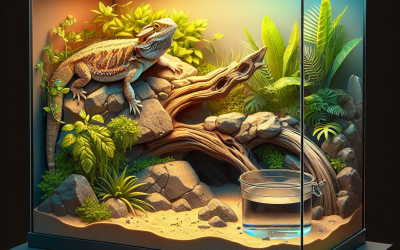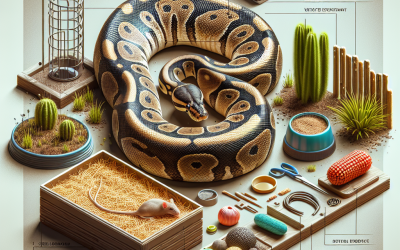Crested Gecko Habitat Setup: The Ultimate Beginner’s Guide
Introduction
Did you know that crested geckos can live up to 20 years in captivity when provided with the right environment? This fascinating reptile has gained immense popularity among pet enthusiasts, and setting up a proper crested gecko habitat setup is crucial for their health and happiness. Whether you’re a seasoned reptile owner or a complete beginner, understanding how to create a suitable living space for your crested gecko can be both rewarding and exciting.
In recent years, there has been a surge in interest surrounding exotic pets, particularly reptiles like the crested gecko. Their unique appearance, calm demeanor, and ease of care make them an ideal choice for many. However, the importance of a well-thought-out habitat cannot be overstated. Recent studies have shown that proper habitat setups significantly impact the overall well-being of reptiles, making it essential for owners to invest time and effort into creating an optimal environment.
In this ultimate beginner’s guide, we will explore the key elements of a successful crested gecko habitat setup. You will discover the essential components needed for a healthy environment, common mistakes to avoid, and tips for maintaining your gecko’s habitat. By the end of this article, you will be equipped with the knowledge and tools necessary to ensure your crested gecko thrives in its new home.
You can expect to learn about:
- The fundamental elements of a crested gecko habitat.
- How to properly set up and maintain your gecko’s environment.
- The common pitfalls to avoid when caring for your crested gecko.
- The exciting trends in crested gecko care and habitat setups.
So, if you’re ready to embark on this journey of creating a fantastic home for your crested gecko, let’s dive in!
What is Crested Gecko Habitat Setup?
Definition
At its core, crested gecko habitat setup refers to the specific arrangements and conditions necessary to create a safe and nurturing environment for your crested gecko. This includes the type of enclosure, substrate, temperature, humidity, and decor to mimic their natural habitat. By replicating their native environment, you can help ensure that your gecko remains healthy, happy, and stress-free.
Historical Context
Crested geckos, originally from New Caledonia, were largely overlooked until they were rediscovered in the 1990s. This led to a boom in their popularity as pets. As more people began to keep them, the understanding of their habitat needs evolved. Initially, many owners kept them in simple cages with little consideration for their environmental needs. However, over time, it became clear that a more complex and naturalistic setup was crucial for their well-being.
Today, we know that a well-structured habitat setup can greatly enhance the quality of life for these reptiles, making it a significant area of focus for both new and experienced breeders.
The Importance of Crested Gecko Habitat Setup
Understanding and implementing an effective crested gecko habitat setup is vital for several reasons:
- Health and Longevity: A well-designed habitat can prevent health issues such as respiratory infections and stress-related conditions.
- Behavioral Enrichment: A stimulating environment allows your gecko to engage in natural behaviors, which can improve their overall quality of life.
- Aesthetic Appeal: A beautifully arranged habitat can serve as a stunning focal point in your home.
Crested Gecko Habitat Setup in the Context of the Pet Industry
The rise in the popularity of crested geckos has influenced the pet industry significantly. Many manufacturers now produce specialized products designed specifically for reptile habitats, including substrates, lighting, and decor. This has made it easier than ever for pet owners to create the ideal environment for their geckos.
Key Players or Contributors
Several organizations and experts contribute to the knowledge surrounding crested gecko care and habitat setups. Reptile enthusiasts, breeders, and veterinarians frequently share valuable information through forums and social media, helping to educate new owners on best practices. Additionally, local reptile societies and online communities offer resources and support for those interested in these unique pets.

Essential Components of a Crested Gecko Habitat Setup
Creating a proper crested gecko habitat setup involves understanding the various components necessary for their well-being. Here are the key elements to consider:
Enclosure
Choosing the right enclosure is the first step in your habitat setup. Here are some factors to consider:
- Size: A minimum of a 20-gallon tall tank is recommended for adult crested geckos. They thrive in vertical spaces due to their climbing nature.
- Material: Glass tanks are popular because they provide excellent visibility and insulation. Ensure that the enclosure has a secure lid to prevent escapes.
Substrate
The substrate you choose plays a significant role in your gecko’s habitat. Here are some options:
- Coconut Fiber: This is an excellent choice as it retains moisture and provides a natural feel.
- Paper Towels: For easier cleaning, paper towels can be used, especially for young geckos.
- Sphagnum Moss: This can be added for humidity retention and aesthetic appeal.
Temperature and Humidity
Maintaining the right temperature and humidity levels is crucial for your gecko’s health.
- Temperature: Aim for a temperature range of 72°F to 80°F (22°C to 27°C) during the day, with a slight drop at night.
- Humidity: Crested geckos thrive in humidity levels of 60% to 80%. Regular misting and a water dish can help maintain these levels.
Lighting
While crested geckos do not require UVB lighting, providing a low-level light source can help simulate a natural day/night cycle, which is beneficial for their overall health.
Decor
Creating a naturalistic habitat involves adding decor that allows your gecko to hide, climb, and explore. Here are some ideas:
- Branches and Vines: These provide climbing opportunities and create a more natural environment.
- Hiding Spots: Use caves, plants, or hollow logs to give your gecko places to retreat and feel secure.
- Live or Fake Plants: Incorporating greenery can enhance the aesthetic appeal and provide additional hiding spots.
How to Set Up a Crested Gecko Habitat
Setting up your crested gecko habitat setup may seem daunting, but following these steps will make it straightforward:
Step-by-Step Guide
- Choose the Enclosure: Select a suitable tank based on the size of your gecko.
- Add Substrate: Layer your substrate evenly across the bottom, ensuring it is deep enough for burrowing (if using coconut fiber).
- Install Heating: Set up a heating pad or a ceramic heat emitter to maintain the appropriate temperature.
- Add Decor: Arrange branches, plants, and hiding spots within the tank for enrichment.
- Introduce Water: Place a shallow water dish in the habitat and consider misting the tank daily.
- Monitor Conditions: Use a thermometer and hygrometer to keep track of temperature and humidity levels.
- Final Touches: Once everything is in place, ensure the enclosure is secure before introducing your crested gecko.
Common Mistakes to Avoid
While setting up your habitat, be mindful of these common pitfalls:
- Overcrowding: Avoid putting too many decorations in the tank, as this can limit your gecko’s space and increase stress.
- Ignoring Temperature and Humidity: Regularly check your habitat’s conditions to ensure they remain within the optimal range.
- Neglecting Cleaning: A clean habitat is vital for preventing health issues. Regularly remove waste and replace substrate as needed.
Maintaining Your Crested Gecko Habitat
Once your crested gecko habitat setup is complete, ongoing maintenance is essential to keep your gecko healthy. Here are some tips:
Cleaning Routine
- Daily: Check for any waste or uneaten food and remove it promptly.
- Weekly: Change out the water, spot clean the substrate, and mist the enclosure.
- Monthly: Deep clean the enclosure, including replacing or washing the substrate, and disinfect the tank surfaces.
Monitoring Health
Keep an eye on your gecko’s behavior, appetite, and appearance. If you notice any changes, such as lethargy or changes in skin color, consult a veterinarian specializing in reptiles.
Trends in Crested Gecko Habitat Setup
The world of crested gecko care is continuously evolving. Some recent trends include:
- Naturalistic Enclosures: More owners are opting for bioactive setups that include live plants and beneficial microorganisms to create a self-sustaining environment.
- Custom Lighting Solutions: While UVB is not mandatory, many owners are investing in specialized lighting to enhance the gecko’s environment and mimic natural conditions.
- Interactive Habitats: Innovative designs allow for more engaging habitats where geckos can explore and interact with their surroundings.
Conclusion
Creating a crested gecko habitat setup is an exciting journey that ensures the well-being of your new pet. By understanding the essential components, implementing best practices, and keeping up with the latest trends, you can provide a thriving environment that allows your crested gecko to flourish.
Remember, the key to a happy gecko lies in a well-planned habitat that mimics its natural environment. Stay informed and continue to learn about your gecko’s needs, and you’ll be rewarded with a healthy, vibrant pet for years to come.
Resource Links:
- reddit.com: … I’ve heard people using paper towels as the ground floor for crested geckos. Is it a safe and good option or would it be better to have some kind of substrate …
- exoticdirect.co.uk: … A glass terrarium is best suited for this species due to the moisture and humidity involved with the care. A wooden vivarium “could” work, if sealed properly.
- flukerfarms.com: Do not over clutter the tank; leave plenty of open space. CRESTED GECKO HABITAT SETUP & CARE. Temperature & Lighting. Crested geckos come from warm subtropical …




0 Comments